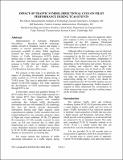| dc.contributor.author | Olson, Wesley A. | |
| dc.contributor.author | Kaliardos, Bill | |
| dc.contributor.author | Zuschlag, Michael | |
| dc.contributor.author | Kendra, Andrew | |
| dc.date.accessioned | 2010-12-02T21:43:00Z | |
| dc.date.available | 2010-12-02T21:43:00Z | |
| dc.date.issued | 2009-12 | |
| dc.date.submitted | 2009-10 | |
| dc.identifier.isbn | 978-1-4244-4078-8 | |
| dc.identifier.uri | http://hdl.handle.net/1721.1/60067 | |
| dc.description.abstract | Implementation of Automatic Dependent Surveillance - Broadcast (ADS-B) technology enables aircraft to broadcast, receive and display a number of aircraft parameters that were not previously available to pilots. While significant research has been conducted regarding Cockpit Display of Traffic Information (CDTI) display format, there is little research to assess the impact this additional information would have on pilot response to Traffic Alert and Collision Avoidance System II (TCAS II) Traffic Advisory (TA)/Resolution Advisory (RA) events. The purpose of this study is to determine the impact of providing directionality information for traffic symbols on a TCAS traffic display during a TA/RA event. This issue is particularly relevant for shared TCAS/CDTI displays. The study supported the development of CDTI performance standards through RTCA, Inc. Twenty-three current and qualified Boeing 737 (B737) pilots flew two 35-minute flight segments in a full motion B737 Next Generation (NG) flight simulator, one flight segment with modified symbology that included traffic directionality information and one with standard TCAS symbology that does not directly provide directionality information. During each flight segment, pilots experienced six separate TA/RA encounters that were counter-balanced to vary encounter geometry, phase of flight and visual conditions. Of the 276 planned RA encounters, 251 RAs actually occurred. In some cases, no RA was received due to either pilot maneuvering (22 cases) or simulator issues (three cases). Dependent measures included pilot responses to TCAS TA/RA encounters and pilot use of TCAS displays as measured by eye tracking data. The results indicate that inclusion of traffic directional information on a traffic display during TCAS TA/RA encounters does not negatively affect pilot response to RAs as measured by timing and magnitude of the RA response. Directional information also yielded no observed effect on pilot scans (allocation of gaze)- . Although effect of symbology was not observed, horizontal and/or vertical maneuvering beyond that commanded by the RA was observed in 90 of 273 possible TCAS TA/RA encounters, independent of symbology. Such maneuvering may be appropriate, depending on the information and context. However, eye tracking and subjective data suggest the maneuvering decisions may be based on the traffic display and not based on visual acquisition or other information. While the overall RA compliance rate was high, the degree of vertical and horizontal maneuvering during the TA/RA event should be better understood since TCAS traffic displays are not intended to support maneuvering. Further research is required to better understand the circumstances in which maneuvering occurs and the resulting impact on the air traffic system. | en_US |
| dc.description.sponsorship | United States. Air Force (Air Force contract #FA8721-05-C-0002) | en_US |
| dc.language.iso | en_US | |
| dc.publisher | Institute of Electrical and Electronics Engineers | en_US |
| dc.relation.isversionof | http://dx.doi.org/10.1109/DASC.2009.5347460 | en_US |
| dc.rights | Article is made available in accordance with the publisher's policy and may be subject to US copyright law. Please refer to the publisher's site for terms of use. | en_US |
| dc.source | IEEE | en_US |
| dc.title | Impact of traffic symbol directional cues on pilot performance during TCAS events | en_US |
| dc.type | Article | en_US |
| dc.identifier.citation | Olson, W. et al. “Impact of traffic symbol directional cues on pilot performance during TCAS events.” Digital Avionics Systems Conference, 2009. DASC '09. IEEE/AIAA 28th. 2009. 5.D.2-1-5.D.2-10. © 2009 IEEE. | en_US |
| dc.contributor.department | Lincoln Laboratory | en_US |
| dc.contributor.approver | Olson, Wesley A. | |
| dc.contributor.mitauthor | Olson, Wesley A. | |
| dc.relation.journal | IEEE/AIAA 28th Digital Avionics Systems Conference, 2009. DASC '09 | en_US |
| dc.eprint.version | Final published version | en_US |
| dc.type.uri | http://purl.org/eprint/type/ConferencePaper | en_US |
| dspace.orderedauthors | Olson, Wes; Kaliardos, Bill; Zuschlag, Michael; Kendra, Andrew | en |
| mit.license | PUBLISHER_POLICY | en_US |
| mit.metadata.status | Complete | |
